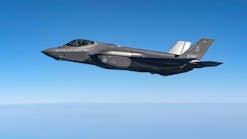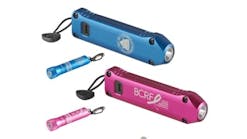Retarding Fire Hazard in Interior Fabrics
Technicians must know the rules for their own protection
By John Boyce
October 1998
The installation of interior fabrics is really no different to the installation of any other component in an aircraft; you have to be aware of the rules and follow them because, as with any other installation, it is the A&P technician who signs off on it and is ultimately responsible for how it functions.
Ethel Dawson, general manager of AccuFleet International, an aircraft interior flammability testing facility in Houston, is careful when answering a question about what she would say to technicians concerning fabric installation.
"Number one," Dawson says, "is to be familiar with FAA requirements for interior compartment materials for that type aircraft (that you are working on). Be very cautious about the materials applied and the treatments done. Always be concerned with re-certification of the material, if needed."
Put another way by Fred M. Walker, owner of Walker Aircraft Interiors in San Antonio, "What the mechanic has to know is that everything they put into that airplane has to be certified. If they do not have the paperwork indicating what fabric it is, who it came from, what (flammability) testing has been done on it; they cannot install it, legally. If the airplane crashes and burns, the mechanic is the one with his signature on there. He definitely wants to make sure the materials are approved (by the FAA)."
Asked where an A&P's liability lies after he returns an aircraft to service with upholstery modifications, Bill O'Brien, the FAA's national resource specialist, says the A&Ps have to meet the performance rules in FAR Part 43.13 and they have the "same liability as if he replaced a standard part. The job must meet type design or properly altered condition for safe operation."
Parts that count
Because most data shows that a substantial percentage of aircraft accident deaths result from fire and smoke inhalation, plus asphyxiation from toxic gasses released during a fire, much of the concern associated with aircraft interiors is the flammability of the materials used in them.
The FAA's rules governing flammability and flammability testing of materials in compartment interiors are mainly contained in Parts 23.853 and 25.853, and Advisory Circular AC25-853-1 for fireblocking and AC23-2 for Part 23 testing.
Generally speaking, the distinction between Part 23 and Part 25 has to do with size and use. Part 23 regulations pertain to smaller "normal utility" aircraft that weigh below 12,500 pounds. Part 25 pertains to transport category aircraft.
There is overlap, but Part 121 (airline operations) and Part 135 (on-demand, charter operations) aircraft fall under Part 25 rules, while Part 91 (corporate, personal-use operations) aircraft fall under Part 23 rules. There are some Civil Air Regulations (CAR) rules involved, but if you follow FAR Parts 23 and 25 rules you will be meeting or exceeding the civil rules pertaining to flammability.
All materials for compartment interiors must be self-extinguishing — either because they are inherently flame retardant, or they have been treated in some manner with a non-corrosive fire retardant. In the case of seat cushions in transport category aircraft, they must be composed of fireproof materials or be fire blocked and completely encapsulated with a material such as Kevlar,® keeping the cushion material — usually polyurethane foam — totally protected from heat and flame. The fireblocking rule addresses cabin passenger seat foam. Foams which are used in other areas of the aircraft must at least meet the minimum requirements for flammability. There is no requirement to fire block seat cushions in non-transport category aircraft; however, they too must at least meet the minimum requirements for flammability.
The rules neither talk about what kinds of retardants are to be used in making materials flame-resistant, nor what materials or fabrics are to be used, but they do specify which kinds of burn tests the materials have to pass to be acceptable.
The FAA, basically, has established two kinds of tests for interior materials; the vertical test and the horizontal test. Three samples of the fabric are tested and the three results are averaged to reach a pass-fail mark.
Both tests have specifications as to the time that flame is applied to the material, depending on the type of aircraft, and thus the rule being applied, but fundamentally, the test determines the material's ability to resist flaming. In the vertical test, the flame is applied with the specimen held in a vertical position; in the horizontal, it is applied with the specimen in a horizontal position.
Knowing the requirements
Where does this leave the technicians who are installing or otherwise working with fabric in the interior of an aircraft? First, they must
understand that some form of fire protection of aircraft interiors is absolutely required, regardless of the size or type of the aircraft. Other than that, what is required of technicians depends on the fabric, the source of the fabric, the type of work being done, and the aircraft. If, for instance, a technician is dealing with fabric that has arrived with no documentation or is known to be non-aviation certified, the A&P, to be risk-free, should get the fabric tested for flammability at an FAA-certified repair station or lab. If it passes, it is safe to install. The DER (Designated Engineering Representative) at the testing site will send it back with the necessary documentation. If it doesn't pass, it has to be treated with a flame retardant, tested again, and certified. The treatment can take place in-house, but the test and the test results have to be certified.
"If there is some question about some fabric," says Walker, "for example, if you get material that doesn't come from one of the companies that make stuff for aircraft, then you have to test it. We send it out for testing. If it fails we treat it and have it re-tested. I have several fabric vendors and all of them certify their materials."
O'Brien cautions that unknowns, in any form, are bad for aviation — "but I would just get the fabric tested and certified by a lab or repair station that is certified to do the testing."
In practice, even if fabric arrives with the necessary certification, it does not necessarily get a stamp of approval from the FAA. It depends on the region, according to Judy Boggs, a DER with Skandia Inc., a testing lab in Rockford, IL.
"In some regions of the FAA," Boggs says, "even if it (fabric) comes with manufacturer's certification, you still have to have it re-tested. Not all the regions interpret the rule that way, but some do. You can't take anybody's word for it."
Installations and STCs
Installing interiors has the potential for becoming an STC issue when the work takes on "major" proportions, according to O'Brien
at the FAA. "Assuming we are talking about replacing the fabric on the seats, headliner, and side walls only, no other modifications," O'Brien says, "then no STC is required as long as the fabric meets the type design of the aircraft. If the fabric that meets the type design also now has flame resistant properties, and that is the only change, then it is a minor alteration. So, the job is a minor repair (replacing the fabric) with a minor alteration (flame resistance)."
"The retardant comes in many chemical forms," according to Drew Clabough, flame treatment manager at Skandia, who uses "seven or eight" different compounds.
"Everything we use is water based," Clabough says. "They're non-corrosive, non-hygroscopic (don't draw moisture from the air). There's no problem with corrosion or skin irritation or anything like that in the future."
Clabough warns, however, that some materials are difficult to treat. "Sometimes we receive materials to treat that have previously been Scotch Guarded® or waterproofed. This makes it difficult for the material to absorb a treatment. 100-percent nylons and synthetics are difficult to treat."
Non-aviation grade leathers usually contain more flammable dyeing and tanning chemicals, which can require heavier concentrations of retardant — which can lead to stiffness.
Clabough concludes by saying that technicians can do their own treatment "as long as they send out a sample of the fabric to get certification." They have to be aware of and follow the rules.
Working with Fire Resistant Foams......
Working with Fire Resistant Foams
By Vicki Saffer
October 1998
Traditionally, many seating manufacturers and upholstery shops have used a fire-retardant polyurethane cushioning which, by itself, is quite flammable and would not be acceptable for this environment. However, with the addition of an inner secondary fire-blocking fabric acting as a barrier between the polyurethane cushioning and the exterior covering, this product can satisfactorily comply with FAA regulations.
While it is true that polyurethane foams are lighter in weight and provide a slight advantage in terms of total aircraft weight, the disadvantages of the use of this cushioning are mainly economic.
The required fire-blocking cover is very expensive, and the extra cost of sewing this cover further adds to the price of the seat cushion assembly. Whatever savings might be achieved through the weight reduction provided by polyurethane foams, are substantially offset by the high cost and labor intensity of this process.
It should also be noted that this fabric will experience wear through time and use, possibly having an adverse effect on the fire performance of the initially certified seat cushioning composite. In addition, a secondary cover can detract from the overall aesthetics, and place limitations on achieving maximum cushioning performance and comfort.
The second option to attain compliance with FAA oil burner testing is fire-resistant foam cushioning. Fire-resistant cushioning inherently does not require the alternate fire-blocking covering fabric to achieve this compliance — eliminating the additional cost of the fabric and the extra labor charges. Although fire-resistant foams are slightly more expensive than fire-retardant polyurethanes, the elimination of any secondary covering more than makes up for the initial price difference.
Many aircraft upholstery personnel do not realize that modifications to this type of cushioning in recent years have substantially improved both performance and comfort, making the use of fire-resistant cushioning an even more attractive and ideal prospect for the aircraft industry. These continued modifications have also resulted in drastic improvements relevant to the aging characteristics of fire-resistant cushioning.
Regardless of which option you choose to use within your operation, it is important that your cushioning supplier is someone qualified to assist you through the certification process. Having someone to guide you through the maze of forms and questionnaires, assist you in collecting all necessary paperwork, and to oversee communication and actual testing between you and the FAA, can help ease the headaches. Ideally, a cushioning manufacturer employing an FAA certified DER can make this process a much smoother and simpler one for you.
Although FAA certification is important, we must not lose sight of the importance of creating a comfortable seat to attain complete customer satisfaction. Remember the customer who performed the "butt" test on the cushions prior to installation? In order to satisfy him, it was crucial that we carefully choose the cushioning firmness used in his (and all) seat cushions designed by our engineers.
Too many times, we have run into cases of upholstery shops not fully understanding (or aware of) the firmness options available to them or how to best combine them to achieve the maximum comfort in their cushions.
The fact is that a comfortable seat can rarely be achieved by using a single cushioning firmness. Upholstery personnel must approach the building of a seat as an art — using a firm cushioning base which graduates to softer external top layers, combined with narrow sides (or wedges) to achieve a firmer support.
The most common complaint related to fire-resistant foams has targeted seat bottom designs. Because the seat cushion is subjected to the majority of weight and takes the greatest degree of punishment, that is the area most often connected with "poor comfort and service life."
Upholstery shop personnel used to working with traditional polyurethanes, will most certainly find fire-resistant foams different to work with initially.
One important difference between traditional polyurethane and fire-resistant cushioning is the "standard" size offering.
Polyurethane is traditionally offered in huge buns as well as sheet stock. Fire-resistant cushioning is normally sold in smaller buns or in specific sheet stock sizes. In order to minimize waste on specific projects, the correct sheet size should be always be ordered and utilized to best suit the cushions being cut in the fabrication process. Many manufacturers offer several standard sizes, and some will supply sheets which best accommodate any fabrication which may transpire within the upholstery shop.
As for cutting various cushioning products, the difference is simple: any blade you might use to cut fire-retardant polyurethanes can be used to cut fire-resistant cushioning. The only exception to this would be a hot wire cutter, which will not work with fire-resistant foams.
You should talk with the cushioning manufacturer regarding the adhesives you plan to use in your operation. There are many types of adhesives supplied within the industry, some solvent-based and some water-based, and not all adhesives will work with all cushioning types. The cushioning manufacturer should be able to supply you with suggested adhesive products that will best work with their foam.
While FAA certification and building the ideal seat are important, we cannot overlook the area of durability. Aircraft owners and commercial airlines alike want a seat that is going to give them their money's worth over time and use.
Service life is important not only for economics, but for aesthetic value as well. Service life of a seat can be attributed largely to the initial cushion construction. If a seat bottom is built using an incorrect choice of lower density cushioning, that cushion will compress, become unsightly and uncomfortable, and will quickly need replacing.
Regardless, when upholstery personnel are selecting firmness for use in their cushions, it is always best to err on the firm side to ensure continued comfortability through normal usage. Any cushioning foam, whether fire-resistant or traditional polyurethane, will experience some in-service loss of firmness initially. Using the correct construction in the original cushion will best ensure the durability and extended service life demanded by the aircraft industry.
When choosing your cushioning supplier, capabilities of importance should include:
• Technical support
• Miscellaneous supplies such as velcro, muslin, strapping, cushioning with fabric backing, adhesives, etc. •ÊFull-scale fire testing capabilities, flotation (TSO) testing capabilities
•ÊProper certification documents for both flammability and flotation testing
Another area that needs to be closely controlled when preparing for FAA certification is document collection. If you request the appropriate detailed invoices, test results (if available) and certification to be forwarded to the DER overseeing the actual testing this process will be a much smoother one for all involved.
Finally, while there may not be a "magic formula" for creating the perfect seat cushion, it could also be said that DaVinci could not have explained to Rembrandt how he painted Mona Lisa. If you approach the building of a seat cushion as you would the creation of a work of art, there is no doubt that you will end up with a safe, comfortable, long lasting seat, and a satisfied customer who will return again and again.




